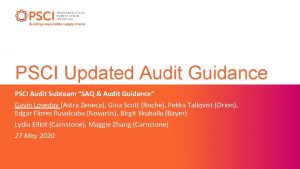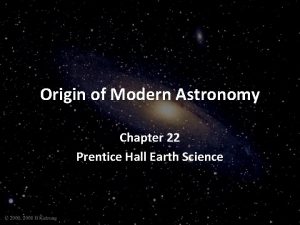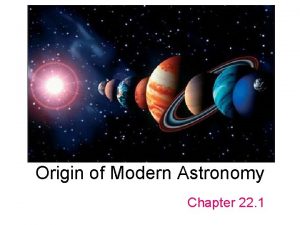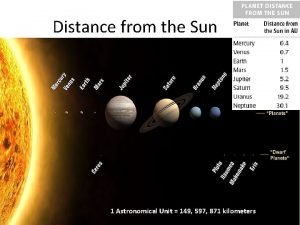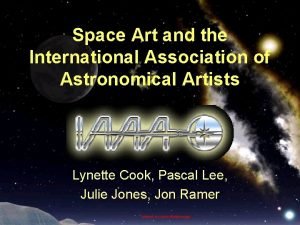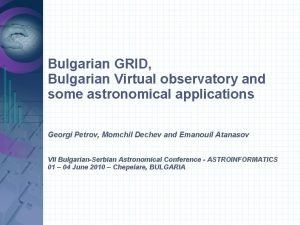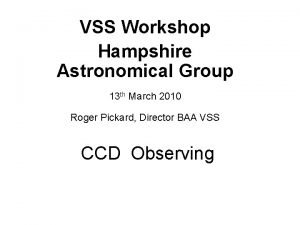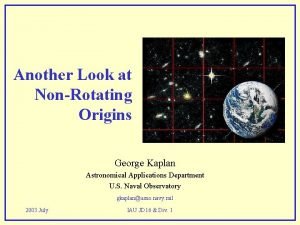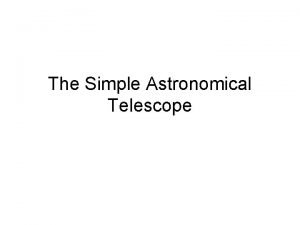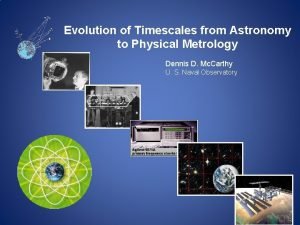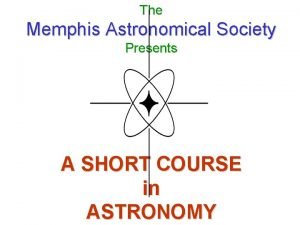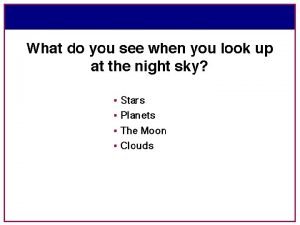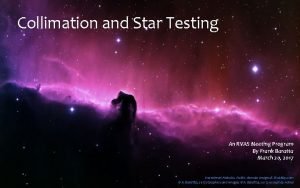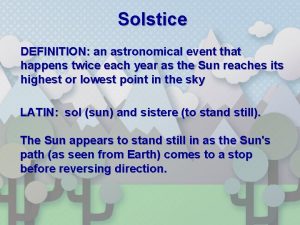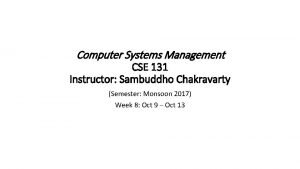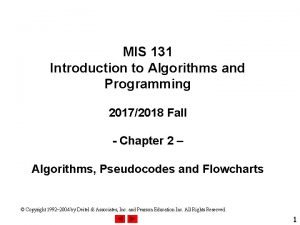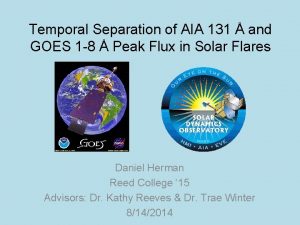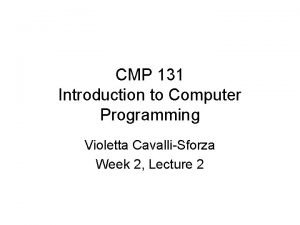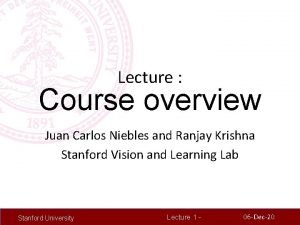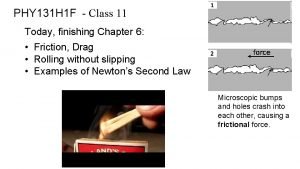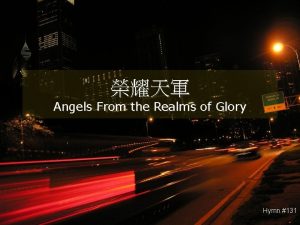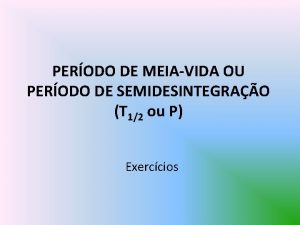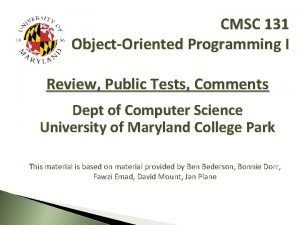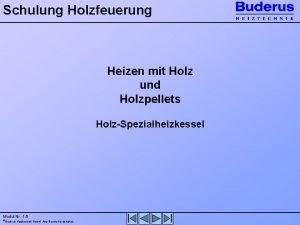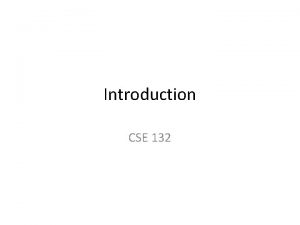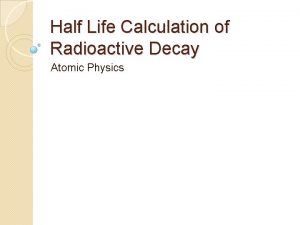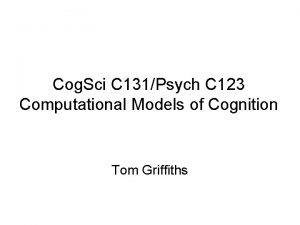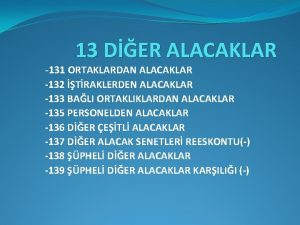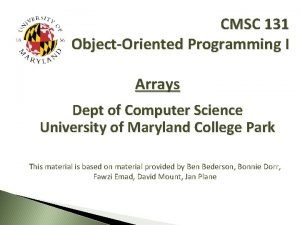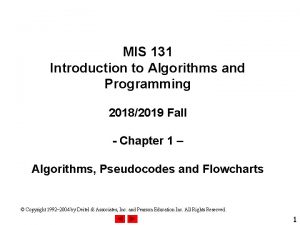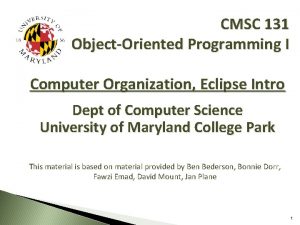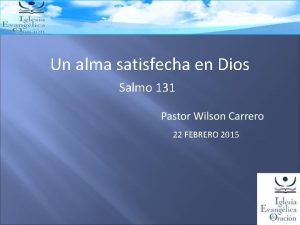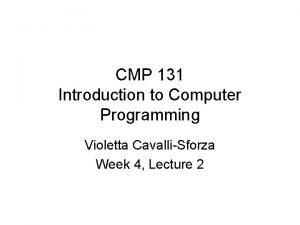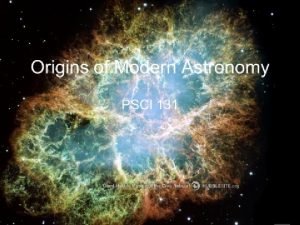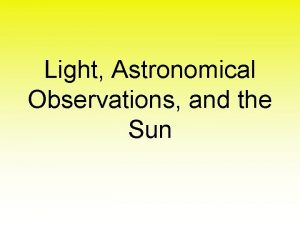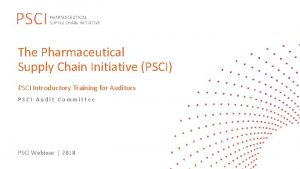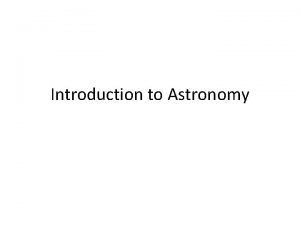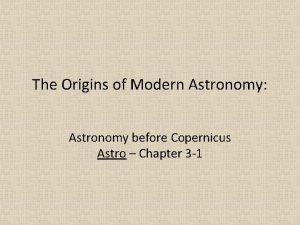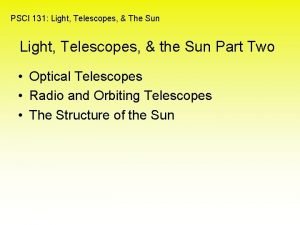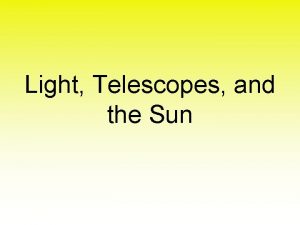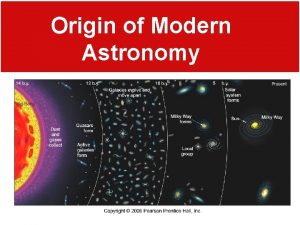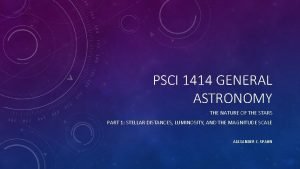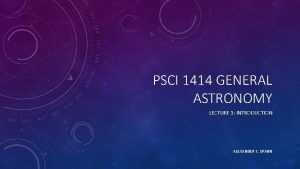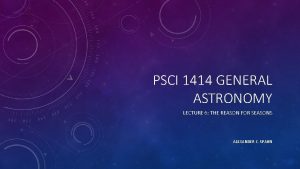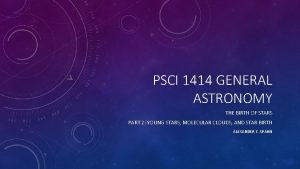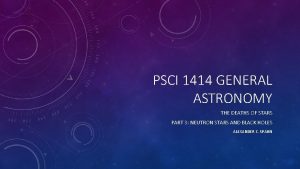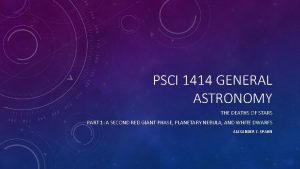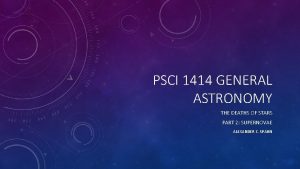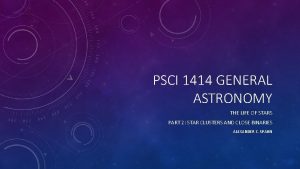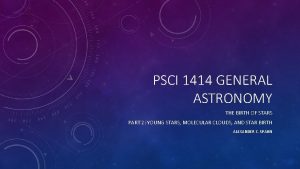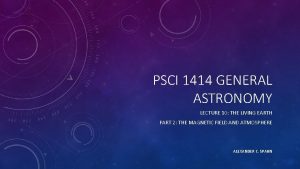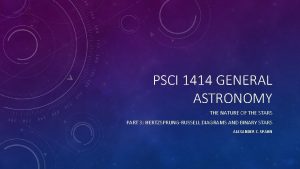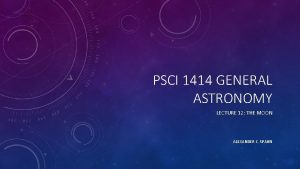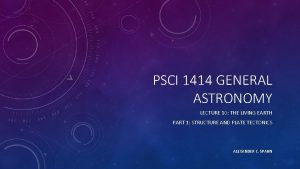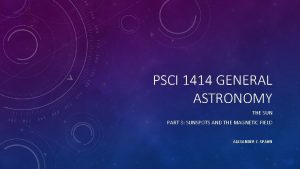Origins of Modern Astronomy PSCI 131 Astronomical Terms



















































- Slides: 51

Origins of Modern Astronomy PSCI 131

Astronomical Terms • Rotation – Motion around an axis – Produces day/night From: physicalgeography. net

Astronomical Terms • Revolution – Motion around another object; orbiting – Produces seasons From: science-class. net

Astronomical Terms • Orbital period – Time required for one revolution – Length of one year for a given planet school-for-champions. com

Astronomical Terms • Orbital distance – Average distance from the Sun Solar system shown to size and distance scale From: commons. wikimedia. org

Astronomical Terms • Astronomical unit (AU) – Distance from Earth to Sun – Used as a “measuring stick” for solar system distances From: wchs-astronomy. wikispaces. com

Astronomical Terms • Parallax – Apparent shift of objects due to motion of observer – Stellar parallax: apparent shift of stars due to Earth’s movement around Sun

Astronomical Terms • Geocentric: Earth-centered • Heliocentric: Sun-centered

ORIGINS OF ASTRONOMY • Ancient Greece (600 BCE – 150 CE) • European Renaissance (1400 s-1700 s)

PSCI 131: Origins of Astronomy –Ancient Greece (600 BCE – 150 CE)

PSCI 131: Origins of Astronomy – Ancient Greece Assumptions of the Ancient Greeks • Universe – Earth – Seven “planetai” (wanderers in Greek) – Stars • Geocentrism From redorbit. com

PSCI 131: Origins of Astronomy – Ancient Greece Question • Which planets are visible in the night sky without a telescope?

PSCI 131: Origins of Astronomy – Ancient Greece Important Discoveries • Earth is spherical – Aristotle (384 -322 BCE) – Observation of lunar eclipses • Since the Earth always casts a curved shadow on the moon it must be spherical From 8 planets. co. uk

PSCI 131: Origins of Astronomy – Ancient Greece What would Earth’s shadow look like if Earth were a flat disk? A B C

PSCI 131: Origins of Astronomy – Ancient Greece Important Discoveries • Earth’s circumference – Eratosthenes – Measuring angle of shadows – Basic geometry Eratosthenes, 276 -194 BCE From 3 villagecsd. k 12. ny. us

PSCI 131: Origins of Astronomy – Ancient Greece Important Discoveries • Earth’s circumference = 360 degrees = ____ stadia • Need distance between two points in degrees and stadia – Distance from Syene to Alexandria was known to be 5000 stadia (about 480 miles) • How did Eratosthenes find distance in degrees? – Angle of shadows in both cities on same day – At Syene: no shadow – At Alexandria: shadow made 7 degree angle

6 km = 1 stadia

PSCI 131: Origins of Astronomy – Ancient Greece Important Discoveries • Heliocentric (sun-centered) solar system – Aristarchus (312 -230 BCE) – Sun much larger than Earth, further away than Moon – Basic geometry – First to attempt to measure the relative distance between the Earth-Moon and the Earth-Sun without the aid of trigonometry.

PSCI 131: Origins of Astronomy – Ancient Greece Important Discoveries • Rejection of heliocentric model – Predicted stellar parallax, but none was observed • Need a telescope to see it – Aristotle championed geocentric model • Stronger influence so geocentric model persisted for nearly 2000 years

PSCI 131: Origins of Astronomy – Ancient Greece Important Discoveries • Star catalog – Hipparchus (190 -120 BCE) – First to realize that ideas must be proven with empirical evidence (observation rather than logic) • Also realized that more data meant more certainty in the idea or model – Created highly accurate star atlases in an attempt to measure the length of the year more accurately • He measured the length of year to within 6. 5 minutes of actual time – He made more detailed corrections to locations and distances measured by Eratosthenes

PSCI 131: Origins of Astronomy – Ancient Greece Important Discoveries • Ptolemaic System – Claudius Ptolemy (100 -160 AD) – Geocentric model – First organized explanation of celestial motion

PSCI 131: Origins of Astronomy – Ancient Greece Important Discoveries: Ptolemaic System • Deferent: orbital path • Epicycles: smaller circles – Used to explain retrograde motion

PSCI 131: Origins of Astronomy – Ancient Greece Important Discoveries: Ptolemaic System • Retrograde motion: “backward” motion of a planet along its orbital path The Ptolemaic System used epicycles to explain retrograde motion

PSCI 131: Origins of Astronomy – Ancient Greece Important Discoveries: Ptolemaic System • Retrograde motion is really an illusion Earth passes Mars in its orbit; Mars appears to move backward as seen from Earth

PSCI 131: Origins of Astronomy –European Renaissance (1400 s – 1700 s)

PSCI 131: Origins of Astronomy – European Renaissance Timeline: Nicolaus Copernicus 1400 Copernicus 1473 1543 1450 First printing press 1492 1776

PSCI 131: Origins of Astronomy – European Renaissance Nicolaus Copernicus • “Copernican Revolution” • After discovering Aristarchus’ writings he became convinced of the Heliocentric model – His model still contained the epicycles to explain retrograde motion • Published his book for the Suncentered solar system model as he lay on his deathbed. – Set stage for later discoveries

PSCI 131: Origins of Astronomy – European Renaissance Timeline: Tycho Brahe 1400 Copernicus 1473 1543 1450 First printing press 1492 1546 1776 1601 Brahe

PSCI 131: Origins of Astronomy – European Renaissance Tycho Brahe • Very precise astronomical observations – Without a telescope – His observations of Mars were far more precise than any made previously. • Geocentrist – He couldn’t observe the apparent shift (parallax) in the position of the stars that should result if the Earth traveled around the Sun.

PSCI 131: Origins of Astronomy – European Renaissance Timeline: Johannes Kepler 1400 Copernicus 1473 1543 1450 First printing press 1492 1546 Kepler 1571 1630 1601 Brahe 1776

PSCI 131: Origins of Astronomy – European Renaissance Johannes Kepler • Brahe’s assistant • Used Brahe’s observations – To prove heliocentrism – To develop laws of planetary motion still in use today

PSCI 131: Origins of Astronomy – European Renaissance - Kepler First Law of Planetary Motion • Orbits are ellipses, not circles • Sun located at one focus of the ellipse • Nothing is at the other focus

PSCI 131: Origins of Astronomy – European Renaissance - Kepler Second Law of Planetary Motion • Law of equal areas • During a given amount of time, a planet will always “sweep out” the same area in its orbit over that time • Planet speeds up as it approaches the sun and slows down far away

PSCI 131: Origins of Astronomy – European Renaissance - Kepler Second Law of Planetary Motion • Orbital speed varies inversely with orbital distance Sl ow er or b ita ls pe ed From: http: //www. wallpaperswala. com/solar-system/

PSCI 131: Origins of Astronomy – European Renaissance - Kepler Third Law of Planetary Motion • Orbital period proportional to orbital distance • p 2 = a 3 • p: orbital period in Earth years • a: orbital distance in astronomical units (AUs) • Example: if p = 8 yrs, a = 4 AUs (8)2 = 64 then 64 = a 3 3√(64) = 4

PSCI 131: Origins of Astronomy – European Renaissance - Kepler Laws of Planetary Motion • Significance – First mathematical model of celestial motion – Not based on philosophical assumptions

PSCI 131: Origins of Astronomy – European Renaissance Timeline: Galileo Galilei Kepler 1571 1630 1400 Copernicus 1473 1543 1564 1450 First printing press 1492 1546 Galileo 1642 1601 Brahe 1776

PSCI 131: Origins of Astronomy – European Renaissance Galileo Galilei • “Father of modern observational science” • Improvements to telescopes – Did not invent them • First astronomer to use telescope

PSCI 131: Origins of Astronomy – European Renaissance - Galileo The Galilean Moons • Discovered four of Jupiter’s moons – Io, Ganymede, Callisto, Europa – First observation of moons other than Earth’s – Showed that Earth isn’t unique in having a natural satellite Sizes of the Galilean moons shown relative to Jupiter From: en. wikipedia. org

PSCI 131: Origins of Astronomy – European Renaissance - Galileo The Galilean Moons Galileo’s notebook showing changing positions of Galilean moons over two weeks Jupiter and the Galilean moons through a small telescope, as Galileo saw them From: physics. wisc. edu From: splung. com

PSCI 131: Origins of Astronomy – European Renaissance - Galileo The Phases of Venus • Observed that Venus goes through phases like Earth’s moon – Proof of heliocentrism From: oneminuteastronomer. com

PSCI 131: Origins of Astronomy – European Renaissance - Galileo The Moon’s Surface • Observed the Moon’s surface wasn’t smooth as the ancients proclaimed – Galileo saw mountains, craters and plains – Moon similar to Earth and not a perfect celestial sphere – Thought plains were bodies of water • Ex. Sea of Tranquility

PSCI 131: Origins of Astronomy – European Renaissance - Galileo Sunspots • Dark regions caused by slightly lower temperatures • Refuted celestial immutability Series of Galileo’s 1612 sketches Sunspots through a modern telescope

PSCI 131: Origins of Astronomy – European Renaissance Timeline: Isaac Newton Kepler 1571 1630 1400 Copernicus 1473 1543 1564 1450 First printing press 1492 1546 Galileo 1642 1601 Brahe 1642 1776 1727 Newton

PSCI 131: Origins of Astronomy – European Renaissance Sir Isaac Newton • Law of Universal Gravitation • Law of Inertia • Explained why planets move in orbits

PSCI 131: Origins of Astronomy – European Renaissance - Newton Law of Inertia (Newton’s First Law) • An object in motion continues in motion with the same speed and in the same direction unless acted upon by an external force From: drcruzan. com

PSCI 131: Origins of Astronomy – European Renaissance - Newton Universal Gravitation • All objects in the universe exert an attractional force on each other • Force increases with mass and decreases with distance – More massive objects exert a greater gravitational attraction than do less massive objects.

PSCI 131: Origins of Astronomy – European Renaissance - Newton Gravity + Inertia = Orbit An orbit is a balance between gravity and inertia


PSCI 131: Origins of Astronomy – European Renaissance - Newton Summary of Newton’s Laws • 1 st Law – A body at rest, or in uniform motion, will remain so unless acted upon by an unbalanced force • 2 nd Law – The change in motion (acceleration) acceleration is proportional to the unbalanced force • 3 rd Law – For every action there is an equal and opposite reaction

PSCI 131: Origins of Astronomy – European Renaissance - Newton Gravity • Gravity is the force that – – holds us to the Earth causes a rock to fall towards the ground causes the Earth to go around the Sun causes the Sun to be pulled towards the center of the Milky Way galaxy • Gravity acts between any two objects even if they are far apart. – “action at a distance” distance
 Learning astronomy by doing astronomy
Learning astronomy by doing astronomy Learning astronomy by doing astronomy
Learning astronomy by doing astronomy Learning astronomy by doing astronomy activity 1 answers
Learning astronomy by doing astronomy activity 1 answers Psci audit
Psci audit Pharmaceutical supply chain initiative psci
Pharmaceutical supply chain initiative psci Rovusastatin
Rovusastatin Chapter 22
Chapter 22 Origin of modern astronomy
Origin of modern astronomy Seasons diagram
Seasons diagram Guildford astronomical society
Guildford astronomical society International association of astronomical artists
International association of astronomical artists Astronomical
Astronomical Hampshire astronomical group
Hampshire astronomical group Astronomical applications department
Astronomical applications department Angular magnification telescope
Angular magnification telescope Astronomical clock lyon france
Astronomical clock lyon france Astronomical time scale
Astronomical time scale Memphis astronomical society
Memphis astronomical society Astronomical coordinates
Astronomical coordinates Star testing astronomical telescopes
Star testing astronomical telescopes Solstice definition simple
Solstice definition simple Combine like terms
Combine like terms Polynomial classification
Polynomial classification In the term oste/o/arthr/o/pathy, which part is the suffix?
In the term oste/o/arthr/o/pathy, which part is the suffix? Cse 131
Cse 131 Mis 131
Mis 131 Aia 131
Aia 131 Kristin spent $131 on shirts
Kristin spent $131 on shirts Violetta 131
Violetta 131 Cs 131 stanford
Cs 131 stanford 131 h
131 h Hmn 131
Hmn 131 Um relogio feito a 50 anos foi fabricado com ponteiros
Um relogio feito a 50 anos foi fabricado com ponteiros Cmsc131
Cmsc131 Hbu 131 uitm
Hbu 131 uitm Buderus schulung
Buderus schulung Cse 131
Cse 131 Radioactive decay of iodine 131
Radioactive decay of iodine 131 In an industrial process nitrogen is heated to 500k
In an industrial process nitrogen is heated to 500k Cog sci 131
Cog sci 131 Ortaklardan alacaklar
Ortaklardan alacaklar Cmsc 131
Cmsc 131 Psalm 131 vers 4
Psalm 131 vers 4 Phy 121 asu
Phy 121 asu Phy 131 past papers
Phy 131 past papers Medical plaza miller 131 miller street
Medical plaza miller 131 miller street Mis 131
Mis 131 Cmsc131
Cmsc131 Salmo 131 2
Salmo 131 2 Violetta cavalli-sforza
Violetta cavalli-sforza Pp-131
Pp-131 The ascent humble
The ascent humble



